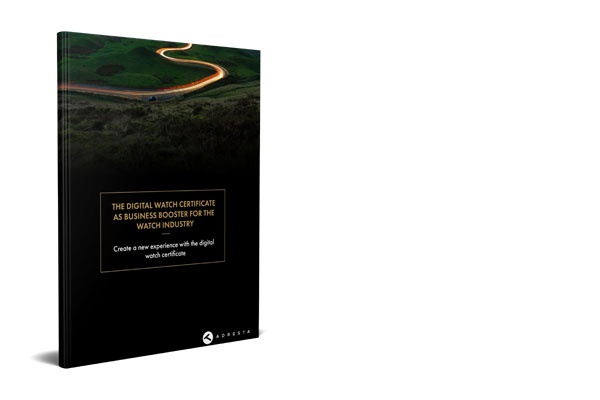Adresta Blog

A digital certificate for every watch - Why is IT the future?
4 Feb 2021
It's impressive to see the impact a digital certificate has in the market - on the part of the manufacturer, retailer and customer. It creates a bridge between the physical and digital worlds. As a result, manufacturers gain new knowledge, new and deep relationships with customers, protect the market against counterfeiting, reduce the need for paper and speed up processes.
Today, a watch keeps quiet about what it has been through. It doesn't tell how many times it has seen a service or how quickly it has changed wrists. This is now changing with the digital certificate, which creates new opportunities for the watch manufacturer.

Knowing history, controlling the market.
All the important stages in the life of a watch are laid out chronologically on a timeline. Like nodes, you can see the sale, service, resale or insurance coverage of a watch. These moments are documented in the digital certificate, encrypted and tamper-proof. What does this mean for the watch manufacturer? The certificate gives new facts that did not exist before. Which watch is changing the wrist at this moment, which one is in service, and is the warranty still active? Answers to these questions give the watch manufacturer the opportunity to control their models on the market. There is no need to gather the facts, because they are automatically documented. There is no need to wait for the data, because it is transmitted in real time. There is no need to evaluate the figures, because the chart for each area draws itself. Summing up, a digital certificate fills knowledge gaps and perhaps even uncovers blind spots in the watch's product lifecycle.
Start a conversation, strengthen the relationship.
How do watch manufacturers accompany their customers through time? Through the digital certificate, the watch manufacturer does not lose contact with the watch owner. The watch itself forms a digital link. The certificate passes to the new owner with the watch, giving the brand a chance to build a new relationship with the owner. This allows a brand to accompany its customer through the entire customer journey. Useful tips on upcoming service, congratulations on the anniversary of his watch, or quite simply background stories can be provided to the customer digitally via the app. By accompanying them through the customer journey, the watchmaker can engage with its customer and strengthen the relationship. A brand grows with its owner, it can learn new things from and with him thanks to regular interaction. Finally, a strong customer relationship also offers scope for further promotions - for example, the exclusive launch of a new series or insurance cover.
Save paper, speed up processes.
A certificate here, a receipt there, internal archives and expensive catalogs - it's easy to underestimate the amount of paper involved in a process. The question arises: Does a customer really need a physical certificate? Does he need a receipt, a folder for his watches? If I as a customer receive a digital receipt and authenticity is guaranteed, a physical twin is unnecessary. The transition may not be easy, but the easier way will prevail. There is no need to scan a certificate for insurance coverage when it is already stored digitally and transmitted one click later. The certificate also makes resale easier because the customer doesn't have to search out documents and receipts, creating trust. Watch manufacturers offer a new experience in the otherwise tedious process path. On the other hand, it relieves the burden on the watchmaker himself when paper is saved and the transmission of information is accelerated digitally.
Exposing counterfeits, increasing sales.
There is only one digital certificate per watch and owner. This means that in the future, a watch will only have value with its counterfeit-proof twin. It will no longer be possible to produce and sell two Rolex from one. Because counterfeiters have to buy a real watch to get the digital certificate and can then only once sell one exact copy with the original digital certificate. Every year, watch and jewelry manufacturers lose 1.9 billion euros in sales due to counterfeiting. From production to the insurance claim, trustworthy data is available thanks to the digital certificate. Counterfeiters then have a difficult time; sales go back to the brands.

